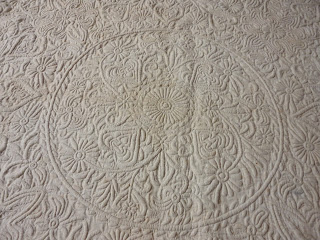The “Mayflower” Quilt
Patricia L. Cummings
The Oldest Known Wholecloth Quilt Brought to America
Perhaps the earliest known quilt found in North American
museum collections is one that at one time was dubiously called, “The Mayflower
Quilt.” Described as being made of linen, the wholecloth quilt was carried
aboard the “Angel Gabriel” galleon by the Cogswell family. Members of the family included John Cogswell
(43) and his wife, Elizabeth (41), and 7 children: William (18), Mary (16),
John Jr. (13), Hannah (11), Abigail (9), Edward, (6), Sarah (3), and Elizabeth,
(an infant). They hailed from Westbury Leigh, Wiltshire, England and the “Angel
Gabriel” departed from Bristol, England in 1635.
Lovely Lane Museum, Baltimore, Maryland, now owns the quilt.
Robert Shindle, Museum Director, noted in an e-mail to me that no facts have
ever been found to support an association of the quilt with the “Mayflower,” a
ship that brought passengers to Plymouth, Massachusetts in 1620.
Indeed, no record can be found of this particular galleon
ever being called “Mayflower.” Originally, it was called “Starne” and was built
for Sir Walter Raleigh to carry him from England to South America. After his
unsuccessful attempt to find gold in Spanish-held territory along the Orinoco
River, he was beheaded. Later, the vessel acquired the name “Jason.” Records
show that at one point, it served to transport cargo such as cotton, lead, and
raisins to the New World. The galleon was renamed “Angel Gabriel” in mid-1619.
Museum Acquires Quilt
According to Shindle, the quilt was purchased from Mrs.
Susan Litch Williams for $85 dollars by Reverend N.T. Whitaker on September
1897 on behalf of Rev. John Franklin Goucher, then President of the Woman’s
College of Baltimore (later Goucher College). Then the quilt was given by Dr.
Goucher’s daughters to a church, now known as Lovely Lane Methodist Church,
when it was in the process of opening a museum in 1954. Rarely seen by the
public, the quilt was published in a 2006 calendar previously offered for sale
by the museum
More Information Found
The “Angel Gabriel,” a 240 ton galleon made of wood and
sails, carried 25 or more passengers on its final voyage to New England, a trip
that was part of the “Great Migration” of Puritans to the New World from 1620
to 1640.
On August 14, 1635, the ship was anchored near Pemiquid
Point, Maine for the night. The passengers disembarked by rowboat, carrying
enough gear to stay on dry land, including the quilt. At 6:30 a.m. the
following day, ferocious winds caused by the “Great Colonial Hurricane of 1635”
smashed the ship to smithereens and washed the shipwreck out to sea leaving
only scattered floating debris on the surface of the water. The vessel was
never seen again, in spite of continued and concerted attempts by searchers who
continue to seek out any remains.
Angel Gabriel: The
Elusive English Galleon / Its History and the Search for Its Remains by
Warren Curtis Riess (Bristol, Maine: 1797 House, 2001), mentions the journal
account of Reverend Richard Mather, written in 1635: “[…] most of the cattle and other goods, with
one seaman and three or four passengers, did also perish therein, besides two
passengers that died by the way,” (“Richard Mather’s Journal,” Chronicles of the First Planters of the
Colony of Massachusetts Bay from 1623-1636, ed., Alexander Young
(Baltimore: Genealogical Publishing Co., 1846).
Galleon Survivors and Their Descendants
Today, a plaque mounted on a rock at Pemaquid Point, Maine
is dedicated to the Cogswell family which later settled in Ipswich,
Massachusetts. A similar plaque honors the memory of Ralph Blaisdell (42), his
wife (age unknown), and their son, Henry (3) of Lancashire, England who later
first went to York, Maine and later settled in Salisbury, Massachusetts. Family
descendants of those shipwrecked still live in New England.
One such person is Barbara Bean Stevens, a resident of
Groton, New Hampshire. She is a direct descendant of John Burnham who at the
age of 10 was allowed by his mother, Mary Andrews Burnham, to accompany his
uncle, Robert Andrews, the captain of the “Angel Gabriel,” along with John’s
two brothers, Thomas and Robert Burnham. In information written for the Groton
Historical Society in their Winter Newsletter (Vol. IV, Issue 4, 2006), Stevens
provided information to Louise Traunstein, Groton Historical Society Archivist
and Newsletter Editor.
Stevens recounted she had read in several historical
accounts that during the hurricane, noted ships were lost at sea, ocean swells were
over 20 feet high, and Indians (Native Americans) had to climb trees for
safety. Hundreds of trees were uprooted and dwellings destroyed as gale force
winds continued for five to six hours. Unlike the Cogswell family, the sea
captain and his nephews escaped only with their lives and nothing else.
A treasured piece of the past, the “Mayflower Quilt” name
evokes a time when Christian believers gathered up their most valuable
possessions and ventured from their familiar surroundings to seek religious
freedom in the New World. We are very lucky that this quilt was saved and has
been preserved in a museum setting. It is an early example of a quilt from a
time when quilters simply used needle and thread to work surface designs in
pleasing patterns. Perhaps, though, it is time that the quilt was called, “The
Angel Gabriel” quilt.
###

No comments:
Post a Comment